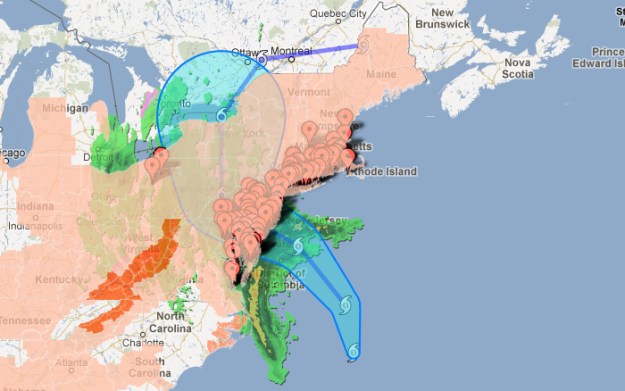 [Update: 11:20 p.m. PST Though the worst of the storm is mostly behind us, an estimated 7.5 million people along the East Coast are still without power. Since publishing its crisis map Sunday, Google has updated its Sandy map to include power outages. If you’re looking at the map on a mobile device, click the “layers” button to see shelter information, storm tracking, and public alerts. For those in New York City, you can access the NYC map here.]
[Update: 11:20 p.m. PST Though the worst of the storm is mostly behind us, an estimated 7.5 million people along the East Coast are still without power. Since publishing its crisis map Sunday, Google has updated its Sandy map to include power outages. If you’re looking at the map on a mobile device, click the “layers” button to see shelter information, storm tracking, and public alerts. For those in New York City, you can access the NYC map here.]
[Originally reported Oct. 28, 2012 at 10:55 p.m. PST] With Hurricane Sandy expected to make landfall along the East Coast of the US on Monday, Google’s Crisis Response team is doing its bit to help those in its path, assembling a special online map enabling people to track the storm and keep up to date with emergency information.
This from Google’s Lat Long blog:
On the map, you’ll find the following emergency preparedness information:
– Location tracking, including the hurricane’s current and forecasted paths, courtesy of the NOAA-National Hurricane Center
– Public alerts, including evacuation notices, storm warnings, and more, via weather.gov and earthquake.usgs.gov
– Radar and cloud imagery from weather.com and the US Naval Research Laboratory
– Evacuation information and routes
– Shelters and recovery centers will appear as they become operational
– Storm footage and storm-related YouTube videos, curated by Storyful
It’s not certain precisely where along the East Coast the hurricane will make landfall – meteorological experts predict anywhere between Virginia and southern New England – though a huge area is expected to be affected as the storm progresses.
With Sandy’s strong winds, heavy rain and snow combining with a storm coming from the west, many cities along the coast are fearing a devastating storm surge. New York mayor Michael Bloomberg is taking no chances, ordering the evacuation of 375,000 city residents located in vulnerable low-lying areas.
Many schools, shops and other businesses along the East Coast will be closed Monday. Thousands of flights have already been canceled and other transportation networks, including New York’s mass transit system, have been suspended too. President Obama, who has canceled election rallies in Colorado and Virginia, attempted to reassure Americans in the storm’s path, saying that “anything they need, we will be there.”
Hurricane Sandy has already caused 60 deaths in the Caribbean in the past week.
The Web will certainly be a great source of information for those caught up in the storm, though of course users will be relying on their network’s ability to withstand the extreme weather conditions about to be visited upon it. Better dig out the AM radio just in case.
[Additional reporting by Jennifer Bergen]


